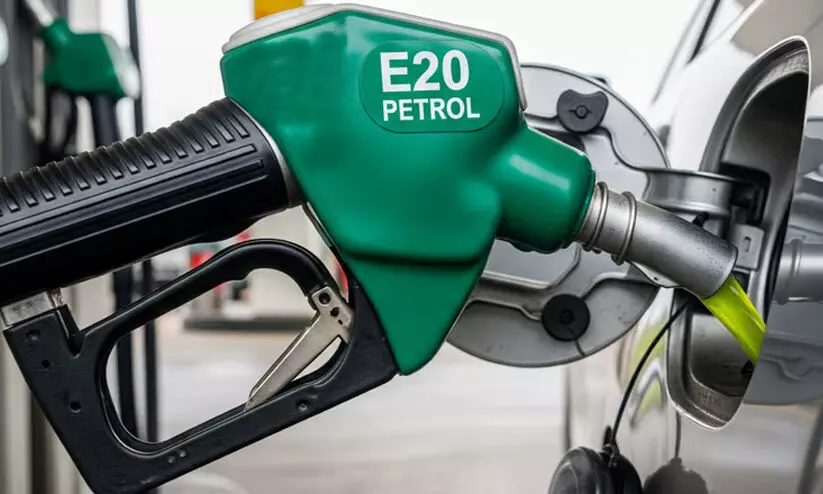E20 petrol row: 8 in 10 vehicle owners say fuel efficiency/mileage reduced in 2025, says survey
A LocalCircles survey found that 80 per cent of respondents who own old (2022 or prior) petrol vehicles stated a drop in their vehicle’s fuel efficiency/mileage in 2025
By - Kedar Nadella |
Hyderabad: According to a LocalCircles survey, as much as 80 per cent of respondents who own old (2022 or prior) petrol vehicles stated a drop in their vehicle’s fuel efficiency/mileage in 2025. The percentage was 67 per cent in August 2025.
The survey was regarding many Indians voicing significant frustrations with the nationwide rollout of E20 petrol (20% ethanol blend), which became mandatory in April 2025.
The compatibility issue
While the government, including Minister Nitin Gadkari, claim no vehicles have been affected and dismisses complaints as ‘misinformation,’ users report real-world problems pertaining to reduced mileage and increased maintenance costs, particularly for vehicles purchased in 2022 or years prior.
Over 80 per cent of petrol vehicles sold in India between 2011 and 2025 (about 234 million) are only compatible with E5 or E10 blends, leaving many owners vulnerable.
As per LocalCircles, based on recent discussions on X (formerly Twitter), there is considerable anguish among vehicle owners.
What kind of engine issues were noticed?
An Audi Q7 owner in Chennai has narrated how he paid Rs 4 lakh in repairs after water-mixed E20 caused engine failure. In another case, a Ferrari refused to start due to E20-induced phase separation; technicians confirmed fuel damage’.
Turbo petrol vehicles like the Toyota Hycross reported three injector failures within 5,000 km, while two-wheelers face misfiring.
According to media reports, mechanics have noted a 40 per cent rise in fuel-related issues since rollout.
The percentage of old (2022 or prior) petrol vehicle owners who confirmed experiencing unusual levels of wear and tear or need for repair in 2025 (beyond regular maintenance and repair) with regard to engine, fuel line, tank, carburettor, etc. rose from 28 per cent in August to 52 per cent in October, the survey stated.
There are also widespread complaints of ‘massive drop in mileage’ across vehicles, with some vehicle owners calling it a ‘slow poison.’
Decrease in mileage
According to the survey, users report 6-20 per cent drops in mileage, increasing fuel costs and consumption despite the ‘green’ intent. NITI Aayog had predicted 6-7 per cent loss for four-wheelers.
The complaints peaked in July-October 2025, with users tagging the Central ministers for fixes like regional non-E20 availability.
Change in fuel efficiency/mileage
The LocalCircles survey asked petrol vehicle owners, “If you have a vehicle that was purchased in 2002 or years prior, how much has the fuel efficiency/mileage of your vehicle(s) reduced in 2025 compared to previous years?”
Out of 18,386 respondents to the question, 16 per cent stated their vehicle efficiency has reduced by over 20 per cent this year; 45 per cent of respondents indicated ‘15-20%’; 13 per cent of respondents indicated ‘10-15%’; 6 per cent of respondents indicated ‘1-2%’; 5 per cent of respondents stated there has been ‘no impact’; and 15 per cent of respondents did not give a clear answer.
To sum up, 8 in 10 petrol vehicle owners with a vehicle that was purchased in 2022 or earlier say their vehicle’s fuel efficiency/mileage has reduced in 2025.
Unusual levels of wear and tear in engin, fuel line, tank, carburettor
Coming to the issue of any damage to the older petrol vehicles, the survey asked, “If you have a petrol vehicle that was purchased in 2022 or years prior, have you experienced an unusual level of wear and tear/ need for repair in 2025 with regards to engine, fuel line, tank, carburettor, etc.?”
Out of 18,385 who responded to the question, 43 per cent stated ‘no, nothing unusual’ had been noticed; 52 per cent of respondents stated ‘yes, definitely’
The percentage of old (2022 or prior) petrol vehicle owners who confirmed experiencing unusual levels of wear and tear, or need for repair in 2025 with regards to engine, fuel line, tank, carburettor, etc. rose from 28% in August to 52% in October.
Why was ethanol blending adopted globally?
Globally, ethanol blending accounts for about 5-6 per cent of transportation fuel demand as of 2024, with the market projected to grow from $98.5 billion in 2024 to $205.2 billion by 2035 at a 6.9 per cent CAGR, driven by mandates and incentives.
Ethanol fuel policies have primarily focused on blending ethanol with gasoline to reduce fossil fuel dependence, emissions, and enhance energy security, varying widely by region.
The United States and Brazil dominate production (80% of global output), but over 30 countries have mandates or targets, often starting at E5 (5% ethanol) and scaling to E10-E27.
These policies stem from the 2000s energy crises and climate goals, but face challenges like feedstock competition (e.g., food vs. fuel) and vehicle compatibility.
Many respondents want E20 petrol to be optional
Given the prospect of a faster wear and tear of vehicles, 52% owners of petrol vehicles purchased in 2022 or prior, stated that if E20 petrol was sold at a 20% lower price and made available on an optional basis, they would support the move. Many of those surveyed shared the view that the government should make E20 petrol optional.
Six months after E20 petrol became mandatory and two months after its initial survey, LocalCircles attempted to find out whether there is any change in petrol vehicle owners’ stance and what the impact is on vehicles manufactured in 2022 or years prior.
Survey demographics
The survey received over 36,000 responses from petrol vehicle owners located in 323 districts of India. As many as 69 per cent of respondents were men, while 31 per cent of respondents were women; 45 per cent of respondents were from tier 1, 27 per cent from tier 2, and 28 per centof respondents were from tier 3, 4, 5 and rural districts.